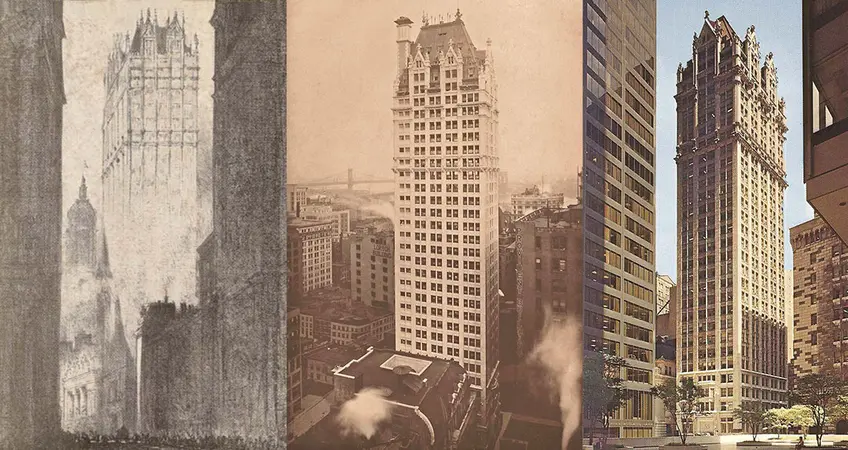 Liberty Tower throughout the years (via Joseph Pell Lombardi Architect)
Liberty Tower throughout the years (via Joseph Pell Lombardi Architect)
In this article:
THEN: New York Telephone Company Building
NOW: Walker Tower, 212 West 18th Street
Architect Ralph Walker designed this building in 1929. It served as a switching station for the New York Telephone Company, and later, a Verizon building. With a monumental presence, this Chelsea art deco tower popularized the textural, setback style of architecture, which was originally developed to heed 1916 sunlight zoning laws that limited the amount of sky a building could obstruct. The intricate brick façade was created with multiple shapes and hues of brick.
“We developed a pre-war unit layout with all of those gracious qualities but with a downtown spin,” Nancy Ruddy of CetraRuddy, the architect for the renovation, told CityRealty. “Entryways are accentuated by ebonized wood portals and beautiful detailing that was not traditional.” Residences have high tray ceilings, eight-foot solid oak doors, herringbone oak flooring, hydronic radiant floor heating, fireplaces, built-in humidification systems, and a home automation system. Amenities include a fitness center, cabana room, landscaped roof deck, yoga room, refrigerated storage, and more.
Prices range from approximately $7.6 million to $45 million.
THEN: New York's City Lunatic Asylum
NOW: The Octagon, 888 Main Street
Starchitect-of-the-era Alexander Jackson Davis, known for his elaborate Hudson River estates, designed the former asylum on Blackwell Island (as Roosevelt Island was named then) in 1834. On a tour of the facility, Charles Dickens wrote that though he found the atmosphere “very painful,” the building was “remarkable,” and the architecture “spacious and elegant.” Constructed from blue-gray stone quarried on the island, the upper portion of this landmarked building features a crenelated cupola and Greek Revival architectural details.
Developer Becker + Becker Associates reinvented the Octagon into eco-friendly rental residences while preserving the historical details and creating a two-acre public park, all with views of the East River and Manhattan skyline. The LEED-Silver certified building has solar panels and fuel cell power, a reclaimed wood spiral staircase and floors, and kitchen cabinets from renewable wheat hulls. Outdoor amenities include waterfront bike paths and tennis courts and hotel-level services like valet service, housekeeping, and onsite childcare.
Rentals start from $2,265/month for a studio and up to $5,548/month for a three-bedroom apartment.
THEN: Sinclair Oil Company Building
NOW: Liberty Tower, 55 Liberty Street
A neo-Gothic landmark in the Financial District, this dramatic building was designed by Henry Ives Cobb and built in 1909. The architect ornamented the cream terra cotta façade with intricate carvings of gargoyles, birds, reptiles, cornices, and flowers that invoke a Gothic church spire. It was the first New York skyscraper to be completely clad in terra cotta. The copper roof rises 64 feet and is adorned with finial-topped pilasters.
Joseph Pell Lombardi Architects converted the building to co-op apartments originally in 1978. Further restoration and renovations were necessary after it sustained damage on 9/11, and these were completed in late 2010. The interiors retain historical details like crown molding, wainscoting, and trey ceilings.
Recent listings range from $520,000 for a one-bedroom to $2.7 million for an architecturally-stunning full-floor four-bedroom penthouse.
THEN: Parking Garage
NOW: 12 East 13th Street
Originally an unremarkable, squat building, 12 East 13th Street started out as a parking garage in 1931. With renovations by CetraRuddy, the open expanse of the original building is retained in the loft-like condominium residences. The red-orange Roman brick façade complements the brownstone neighborhood while the oversized, gridded windows reflect its industrial origins. A four-story, curved glass structure added to the top created a spectacular penthouse.
The eight über-luxurious residences include four four-bedrooms, two floor-through duplexes with private terraces, and a massive triplex penthouse. Interiors merge mid-century modernism and traditional design featuring marble bathrooms with Zebra gray honed Italian limestone floors and free-standing bathtubs that evoke times past. Gourmet kitchens blend elegant mid-century-style cabinets with marble and stainless steel islands. Ownership comes with a robotic parking spot that automatically parks and delivers your vehicle.
Recent sales include an over 5,000-square-foot penthouse that ending up selling for $11.5 million, down from the $30 million it was originally asking in 2014.
THEN: New York City Police Headquarters building
NOW: The Police Building, 240 Centre Street
The landmarked granite and limestone Beaux-Arts building was designed in the Edwardian Baroque style by the firm of Hoppin & Koen and completed in 1909. It served as police headquarters until 1973. The ornate architecture includes cupolas, cornices, skylights, copper walls, mounted sculpture, Corinthian columns, and a central pedimented pavilion topped by a copper dome.
The building stood vacant for a decade until Ehrenkranz Eckstut & Kuhn Architects converted it into remarkable co-op apartments. Out of the 55 units, the only current availability is unit 5H,
a 6,600-square-foot duplex that once held the Police Building's gymnasium. It was designed from the ground up by the famed late architect Charles Gwathmey and took over four years to complete. The asking price is $15.5 million.
THEN: Parish House of St. George’s Church
NOW: The Abbey Condominium, 205 East 16th Street
Architects Charles Otto Blesch and Leopold Eidlitz built the former parish house of St. George’s church in 1888 in the Romanesque Revival style. The landmarked brownstone building with arched windows, gabled rooflines and towers was converted to condominium apartments in 2005. It is located in Gramercy Park.
One-of-a-kind details include massive stained glass windows, marble wainscoting, 18-foot ceilings, elaborate molding and columns, inlaid wood floors, and floor-to-ceiling arched entryways. In the marble and granite lobby, stained glass skylights illuminate the elevator hall. And most incredibly, the penthouse (you can see several pictures of this space above) sold for $55.5 million back in 2009.
THEN: Brooklyn Trust Company Headquarters
NOW: The Brooklyn Trust Company Building, 138 Pierrepont Street
Located in Brooklyn Heights, this landmarked building was designed by bank starchitects Edward York and Philip Sawyer to resemble the Palazzo della Gran Guardia in Verona, Italy. It opened for business in 1913. Constructed of rusticated and smooth-faced limestone, it features a double-height arcade and mezzanine level. The piano nobile features a double-height colonnade with Corinthian columns and pilasters, vaulted ceilings, and a Cosmati mosaic floor in the banking hall.
Barry Rice Architects converted the upper floors into 12 condominium residences with distinctive layouts and skylights, quartzite and marble countertops, and top-of-the-line appliances. Amenities include a music room, gym, lounge, roof deck, children’s playroom, a lobby mudroom, and a dog spa.


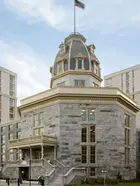
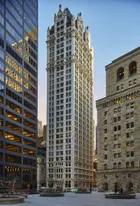
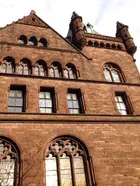
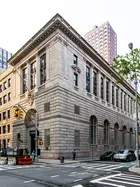
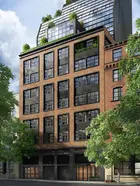

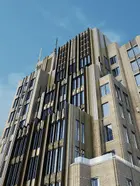
 6sqft delivers the latest on real estate, architecture, and design, straight from New York City.
6sqft delivers the latest on real estate, architecture, and design, straight from New York City.
